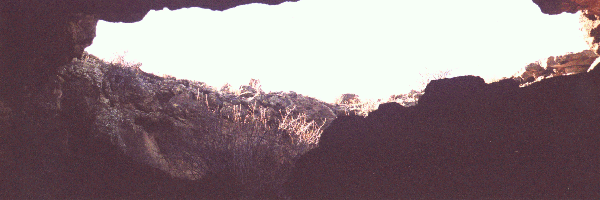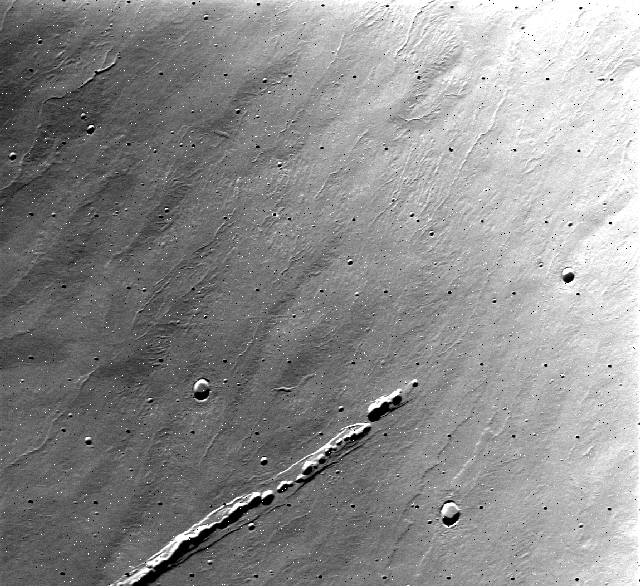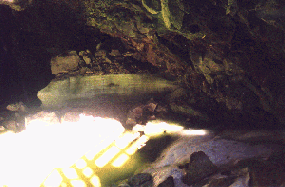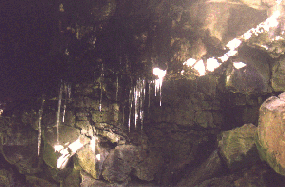
Lava tube entrance, Malpais National Monument, New Mexico
Lava Tubes and Their Potential as Base Sites for Human Exploration of Mars
S. E. Clifford, May 1997

Abstract: Lava tubes form when narrow lava channels crust over, build levees which arch over the channel and converge, or prograde through a series of toes at the front of a flow. Tube morphology is controlled by eruption rates, flow regime, thermal erosion, pre-existing tubes, and topography. Lava tubes are known from Martian regions of basaltic volcanism by surface ridges and collapsed tubes visible in Viking orbiter photographs, with the best evidence coming from Alba Patera and the Tharsis and Elysium volcanic provinces. Methods for searching for intact lava tubes include Earth-based very long baseline radar, orbital radar and photographic searches, kinetic penetrators, seismic surveys, and mobile surface exploration platforms.
Advantages of lava tubes as base sites are sheltered environments, constant temperatures, and freedom to use cheaper, lighter-weight construction materials and less shielding and insulation for humans and equipment in the base. Drawbacks include difficult access and possible distance from necessary resources. Issues to be addressed include volatile distribution and contamination of the tube atmosphere, structural properties of tube roofs, and geographic relationships with potential resources.
Introduction:
In the quest to colonize other planets, one of the primary concerns is finding a way to safely house human beings in a hostile environment. With the budget for space exploration decreasing almost every year, it has now also become very important that this be done as cheaply as possible. This necessity has spawned the idea of “living off the land” by using native materials and features to meet human requirements wherever possible. One of the more infrequently discussed methods of solving the housing problem according to this motto is to build shelters inside intact lava tubes. Some research into this possibility has occurred in the discussion of lunar colonization, but has played no significant part in plans for Mars thus far. This paper will focus first upon the general properties of lava tubes and current knowledge about Martian lava tubes. Discussion of lava tubes as base sites on the Moon will be reviewed and extended to include Mars as well.
Formation:
Lava tubes are only known to form in fluid, pahoehoe-type basaltic lavas at intermediate to high rates of eruption comparable to Hawaiian-style volcanism; extremely high eruption rates, such as those associated with the Columbia River flood basalts, do not appear to produce lava tubes (Greeley, 1975, p. 53). Greeley (1971, p. 222-223) describes several methods by which tube roofs can form over narrow lava channels. The most common method for lava in laminar flow is simple crusting over of the flow surface by one of several means. Scum or crust may fuse to the sides of the channel to form “awnings” which intercept other solid material floating past and accrete across the surface. This can be thickened by cooled lava on the underside or on top due to overflows. Crustal plates formed this way may also break off and float down the channel until they become jammed and fuse together. Crust may also form at the channel edges and merge toward the center in a medial line of closure similar to a zipper.
Greeley also describes roof formation over more rapid, turbulent flows. Levees form as a result of splashing, spattering, and overflows. In some cases the levees may begin to arch over the channel until they meet in the middle and fuse to form an agglutinated roof.
The last method Greeley describes occurs at slow-moving flow fronts, where lobes and toes of lava break out of the main flow. These may crust over as soon as they form, extending the roof while new toes break through the crust in the faster-flowing middle and keep the system moving forward.
Morphology:
Prolonged eruptions usually tend to establish a master channel through which the majority of the flow is conducted (BVSP, 1981, p. 710). This main channel may sometimes be the source of numerous smaller distributary channels which branch off and frequently become “clogged up, resulting in sudden outbursts of lava which were flung into the air, forming spatter” (Greeley, 1971, p. 208). Major tubes are quite well-insulated, as shown by a 12-km tube formed during the 1969-1971 activity of Mauna Ulu on Kilauea, Hawaii, in which lava only experienced a 10-20° C drop in temperature over the length of the tube. As a result, lava can remain hot long enough to flow long distances and may enlarge the tube through thermal erosion. Turbulent flow, which produces much greater heat transfer rates than laminar flow, is probably the most effective situation for this to occur in (BVSP, 1981, p. 710). Dimensions of terrestrial lava tubes may be up to 15 m in diameter and 20 km long, but most are less than 10 m wide and 1-2 km long (Hörz, 1985, p. 406).
A single long tube may show a variety of features over its length. Near-surface tubes are rarely roofed over for their entire length, frequently roof failures ranging from small collapsed “skylights” to long sections of collapsed tunnels. If lava erodes through the roof of another tube below, it may be rerouted, shutting off the remainder of the first, or it may fill up the lower tube and continue down the original path. Some sections of tube may be shut off in favor of easier directions, similar to the way oxbow lakes are formed. Overflows, spatter, and arched roofs form topographic highs along the axes of channels and tubes (Greeley, 1971). Small cones may form around pseudovents where lava breaks out through the surface under pressure in a blocked tube (Carr, 1981, p. 97).
The gradient of the surface beneath the flow partially determines whether or not a flow meanders or remains relatively straight. Gentle slopes tend to produce a greater degree of meandering and branching. Large eruptive surges may cause lava to rupture tube roofs and overflow, possibly into other pre-existing channels, resulting in braided flow systems. This is most common near the vent area. Lava tubes often follow topographic features such as streambeds, faults, fissures, and grabens, and old tubes are often reused and modified by succeeding eruptions as well (Greeley, 1975, p. 54).
Lava tubes on Mars:
The Viking orbiter mission imaged 100% of the surface of Mars at 200-m resolution, and at least 30% at 50-m resolution (BVSP, 1981, p. 773), and individual lava flows are clearly visible over much of the planet. Combined with the classification of most Martian volcanic structures as shields (Hodges and Moore, 1994), it appears that the dominant volcanic process on Mars is the eruption of basaltic lava. This is most evident in the Tharsis volcanic province, where several shield volcanoes have grown to titanic proportions. This area has been carefully imaged and studied, and large lava flow structures are easily visible at the available resolution which will be used as examples in this section.
By far the best evidence for lava tubes on Mars comes from Alba Patera, which lies north of the main Tharsis complex. It is a low, inverted-saucer-shaped volcano which, although only 3 km high, is 1500-2000 km across and the largest volcano on Mars by area. Radial ridges on the flanks of the volcano are up to 350 km long and generally 5-10 km wide, “although the outer margins are often obscured by later flows channeled between the ridges” (BVSP, 1981, p. 779-780). Many of the ridge crests contain an axial channel, generally less than 500 m across, or a line of pits over most of their length. Low mounds and conical features are superposed on the ridge in places, or the ridge may break up into a string of cones up to 10 km across; these features resemble pseudovents on terrestrial volcanoes (Carr, 1981, p. 103). The western flank of Alba Patera also shows localized dendritic channel patterns resembling terrestrial fluvial systems, which have been attributed to “distributary (second order) lava tubes formed by budding of multiple flows through upstream (first order) lava tubes” (Hodges and Moore, 1994, p. 39).
Alba Patera displays two primary lava flow morphologies associated with different rates of effusion. Sheet flows may be tens of kilometers wide and several hundred kilometers long, and are generally tabular with lobate flow fronts and level surfaces lacking in features such as channels or unroofed lava tubes. These are associated with rapid eruption of great volumes of lava and compare well with terrestrial flood basalts, which also do not display lava tubes. “The tube-fed ridge flows also involve large volumes of lava that may have been erupted at a somewhat slower rate. The tube/channel flows are more characteristic of prolonged eruption of lavas which built up thick piles of overlapping flow units” (BVSP, 1981, p. 779-780).
The northeast flank of Ascraeus Mons, the northernmost volcano in the Tharsis chain of three giant shields, shows a particularly good example of collapsed lava tubes or channels, some possibly a kilometer or more across, in a lava fan. Leveed channels, lava-tube ridges, and collapsed lava tubes are also common on the flanks of Olympus Mons, Arsia Mons, and Pavonis Mons as well (Hodges and Moore, 1994). Flows in lava plains associated with both Tharsis and Elysium provinces also appear to have been emplaced by systems of lava tubes and channels (BVSP, 1981, p. 785).

Searching for intact lava tubes:
So far, the only evidence that exists for extraterrestrial lava tubes comes from visual images taken from orbit, a very general tool for planetary exploration. In the case of the Moon, some methods of exploration more specifically tailored for sensing lava tubes have been proposed. Some of these may be extended to the exploration of Mars as well.
One alternative is the use of Earth-based radar using very long baseline (VLB) techniques with frequencies that penetrate the lunar surface. This could produce a synthetic aperture large enough to image large lava tubes within 200 m of the lunar surface. Calculations indicate that a baseline length equal to the diameter of the Earth would provide a resolution of 25.77 m along an axis parallel to the baseline. Increasing the baseline length can be done using satellites, and three-dimensional imaging should be possible given the large diameters (up to 380 m) suggested for the largest lunar lava tubes (Billings, 1991, p. 255-256). Earth-based radar has previously been used to image the surface of Venus in the 1960s, prior to the Magellan mission, with resolution ranging from 1 to 20 km (Ford et al., 1993, p. 1). Technology has improved significantly since that time; however, it is doubtful that high enough resolution could be provided by this method to detect lava tubes on Mars except at great expense.
Orbital and surface methods show greater promise for extension to other planets. From orbital platforms it should be possible to achieve 1-m resolution using earth-penetrating radar (EPR) interferometry (York et al., 1997). Earth-based radar imaging might allow spacecraft to use smaller search areas from lower orbital altitudes to achieve higher performance (Billings, 1991, p. 256). Kinetic penetrators and high-resolution seismic arrays could be used at the surface to detail likely sites. Mobile surface explorers carrying lidar, microwave, or optical equipment could map interior volume to 10-cm resolution moving along the length of the tube. Other surface exploration sensors, including optical spectrometers and imagers, IR and UV spectrometers, lasers, neutron activation analysis, vapor detectors, and probes, may also be used effectively in lava tubes (York et al., 1997).
Lava tubes as bases for human exploration:
Lava tubes have a number of distinct advantages as locations for human habitation on other planets. Many of the ideas in this section were expressed by Friedrich Hörz (1985, p. 409-411) with respect to conditions on the Moon. Extrapolations for Martian environmental conditions are strictly mine.
The surface of Mars receives a significantly larger amount of dangerous solar radiation due to its thinner atmosphere and weak magnetic field. Housing astronauts on the surface would require hauling heavy and costly radiation shielding along, reducing the amount of space and mass available for other supplies, such as scientific equipment. The thin atmosphere and proximity to the asteroid belt also increase the probability of surface impacts by meteorites. Lava tubes buried by a few tens of meters of basalt would provide excellent protection from most small impacts.
Such a well-shielded environment would allow the use of much lighter and thinner materials for construction. Thin-foil metals, plastics, and composites could easily be used, including those which might deteriorate under heavy radiation exposure, and structures supported by air pressure alone might even be reasonable. On Mars, where weather is also an important consideration, little or no protection from the annual planet-wide sandstorms would be required within a lava tube, except near the entrances, which could be sealed off. General wear and tear on a structure could be minimized to a large degree by building in this type of environment. Much of the infrastructure required to run a permanent base (duct work, pipes, valves, storage tanks, etc.) could be left exposed as it would on earth, and creation of specific operating environments for certain equipment would be made easier.
Another advantage of subterranean accommodations is a fairly constant-temperature environment, in contrast with the large day-to-night and seasonal temperature ranges experienced at the surface. This could reduce the requirements of environmental control systems and increase the operating efficiency of exposed machinery. Humans working inside the tube could wear lighter, more flexible suits without as much need for thermal insulation.
Lava tubes do present some drawbacks as base sites. Accessibility may be quite difficult in many cases, especially since many are visibly accessible only through collapse roof sections. This would greatly hinder or prevent driving vehicles in and out and importing resources. Some, however, may be open at the ends or have negotiable slopes leading down to the floor. The other major difficulty could be proximity to resources. Lava tubes in the middle of vast fields of lava, like those around Alba Patera, might be far from the nearest sources of water and mineral resources. Lava flows erupted on more uneven terrain of non-volcanic origin would be better candidates for base sites, as these would have been channeled through low-lying areas, leaving other rock types exposed in between.
One other idea that has been proposed for the case of the Moon is that the sheltered environment and consistently cold temperatures in lava tubes may serve as a kind of trap for water ice and other volatiles (Billings, 1991, p. 256). This may be an even greater possibility on Mars, where evidence for subsurface water is extremely abundant. Since proximity to a source of water is one of the primary criteria for selecting a base location, this possibility alone makes lava tubes formidable candidates for settlements if proven correct.


Conclusions:
Much is currently known about the formation and evolution of lava tubes on Earth. Sufficient identifiable surface features exist to make them important analogs to volcanic processes on other planets. Evidence for lava tubes on Mars does exist, but it is limited in resolution and variety of form to orbital photographs with 50-m to 200-m resolution. Lava tubes do appear to be fairly common on Mars, where basaltic volcanic features are widespread and occur at a large scale. Sufficiently advanced remote sensing and surface exploration technologies currently exist which can be deployed to produce much more detailed surveys of lava tubes on Mars. Strong arguments have been made in favor of using lava tubes as bases on the Moon, and these arguments transfer easily to a Martian settlement scenario as well. Arguments against this use of lava tubes are few and can most likely be worked around.
There are a number of other issues that need to be addressed as well in order to determine the feasibility of lava tubes as base sites. The distribution of volatiles in the immediate vicinity of the tube walls and their transmissivity through the rock and into the atmosphere of the tube is important to know how to prevent toxic contamination of the breathable atmosphere. One type of lava tube roof may be structurally stronger than another, which could be important in shallower tubes. Dimensions of Martian lava tubes are needed for engineering purposes, and knowledge of the distribution with respect to important resources and to each other is vital to picking appropriate site locations and planning eventual base expansion. Once a site has been chosen, it will be necessary to explore the interior to determine whether suitable conditions exist for easy construction (smooth walls and floors, lack of lava-drip features, dust, wall fractures, etc.), and to search for possible water ice within.
The future looks promising for the study of Martian volcanism. Mars Global Surveyor is expected to provide higher-resolution images of the surface beginning later this year, which should significantly aid the visual search for tube-related structures and openings. Numerous other missions are also planned which might provide valuable data as well, and remote exploration of potential base sites for the first landing on Mars may be little more than a decade away.
References:
Basaltic Volcanism Study Project (1981) Basaltic Volcanism on the Terrestrial Planets. New York, Pergamon Press, Inc. 1286 pp.
Billings, Thomas L. (1991) Radar Remote Sensing of Lunar Lava Tubes from Earth. Journal of The British Interplanetary Society, v. 44, p. 255-256.
Carr, Michael H. (1981) The Surface of Mars. New Haven, Connecticut, Yale University Press, 232 pp.
Ford, John P., and 7 others. (1993) Guide to Magellan Image Interpretation. Pasadena, California, Jet Propulsion Laboratory, 148 pp.
Greeley, Ronald. (1971) Observations of actively forming lava tubes and associated structures, Hawaii. Modern Geology, v. 2, p. 207-223.
Greeley, Ronald. (1975) The significance of lava tubes and channels in comparative planetology (abstract). Papers Presented to the Conference on Origins of Mare Basalts. Houston, Texas, Lunar Science Institute, p. 55.
Hodges, Carroll Ann, and Moore, Henry J. (1994) Atlas of Volcanic Landforms on Mars. U. S. Geological Survey Professional Paper 1534. Washington, D.C., U. S. Government Printing Office, 194 pp.
Hörz, Friedrich. (1985) Lava Tubes: Potential Shelters for Habitats. In Mendell (1985), p. 405-412.
Mendell, W. W., editor. (1985) Lunar Bases and Space Activities of the 21st Century. Houston, Texas, Lunar and Planetary Institute, 886 pp.
York, C. L., Walden, B., Billings, T. L., and Reeder, P. D. (1997) Lunar Lavatube Sensing (abstract), on Lunar and Planetary Institute online abstract archive search, URL: http://cass.jsc.nasa.gov/htbin/ols/mtgkeywform?all&All+Meetings&